The Kaveri Refresh 'Godavari' Review: Testing AMD's A10-7870K
by Ian Cutress on June 1, 2015 11:59 AM ESTProfessional Performance: Linux
Built around several freely available benchmarks for Linux, Linux-Bench is a project spearheaded by Patrick at ServeTheHome to streamline about a dozen of these tests in a single neat package run via a set of three commands using an Ubuntu 11.04 LiveCD. These tests include fluid dynamics used by NASA, ray-tracing, OpenSSL, molecular modeling, and a scalable data structure server for web deployments. We run Linux-Bench and have chosen to report a select few of the tests that rely on CPU and DRAM speed.
C-Ray: link
C-Ray is a simple ray-tracing program that focuses almost exclusively on processor performance rather than DRAM access. The test in Linux-Bench renders a heavy complex scene offering a large scalable scenario.
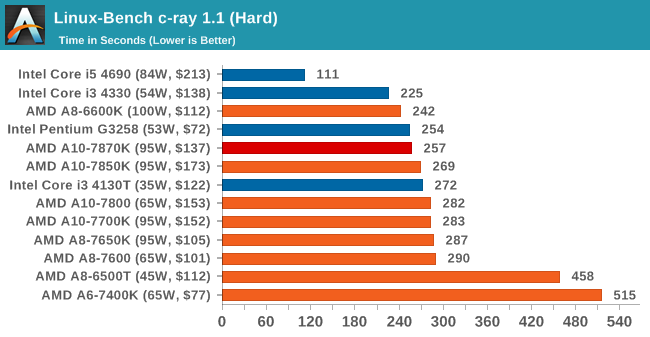
NAMD, Scalable Molecular Dynamics: link
Developed by the Theoretical and Computational Biophysics Group at the University of Illinois at Urbana-Champaign, NAMD is a set of parallel molecular dynamics codes for extreme parallelization up to and beyond 200,000 cores. The reference paper detailing NAMD has over 4000 citations, and our testing runs a small simulation where the calculation steps per unit time is the output vector.
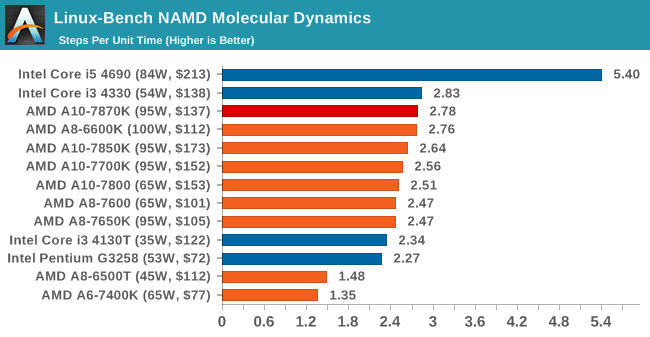
NPB, Fluid Dynamics: link
Aside from LINPACK, there are many other ways to benchmark supercomputers in terms of how effective they are for various types of mathematical processes. The NAS Parallel Benchmarks (NPB) are a set of small programs originally designed for NASA to test their supercomputers in terms of fluid dynamics simulations, useful for airflow reactions and design.
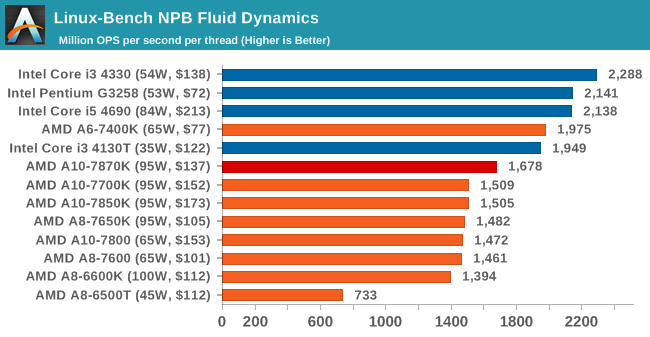
Redis: link
Many of the online applications rely on key-value caches and data structure servers to operate. Redis is an open-source, scalable web technology with a strong developer base, but also relies heavily on memory bandwidth as well as CPU performance.
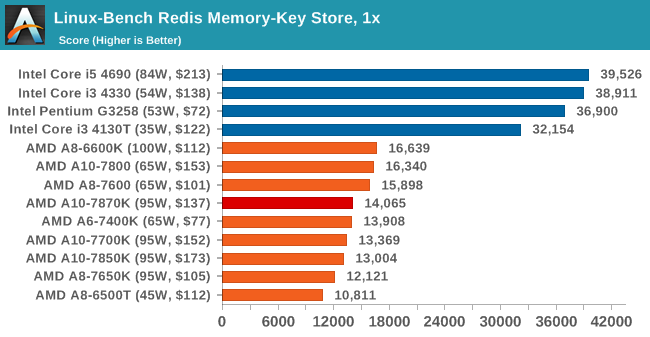

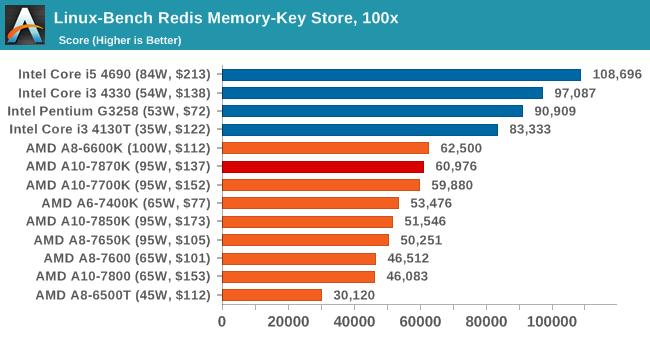










140 Comments
View All Comments
msroadkill612 - Thursday, May 23, 2019 - link
Your words are sage indeed sir. Reading them in 2019 it is clear how right you are. Of course your suggested combo is better buying for gaming performance.Cryio - Monday, June 1, 2015 - link
8320E? That's almost as expensive as the 8350.The best bang for the buck in AMD's portofolio is the 8300. Yes, you've read that right, 8300. Same TPD as the 8320E with some frequencies, same overclock capabilities and for 20% cheaper. It's only slightly more than an FX 6300.
Oxford Guy - Tuesday, June 2, 2015 - link
The 8320E is $100 from Microcenter.Cryio - Tuesday, June 2, 2015 - link
Then awesome. But generally, the 8300 is the cheapest you can buy.Dresdenboy - Monday, June 1, 2015 - link
What is the BIOS version being used? And what was the voltage?According to CPU World there might be heavy throttling with a somewhat older BIOS. The newer version fixes the problems:
"Update (May 31): Throttling problem was fixed by upgrading to P2.60 BIOS. Thanks to Roger Harshman for the hint! The processor is stable now, and runs CPU benchmarks and games without throttling and lockups. By the way, new BIOS sets lower core voltage, close to 1.45V."
Cryio - Monday, June 1, 2015 - link
The only thing that saddens me is that on average, the iGPU in the 7870K is still just 3 fps faster on average than a 240 DDR3.On paper, the iGPU should be as fast as a 7750 GDDR5 ! Not to mention the iGPU is based on GCN 1.1.
But for whatever reason, it's still 50% slower than it should be.
frozentundra123456 - Monday, June 1, 2015 - link
No, it has the same number of shaders as the 7750, but lower clocks, less bandwidth, and a limited thermal envelope. I don't know why you think it should be as fast as the 7750.Cryio - Monday, June 1, 2015 - link
Same number of shaders (both have 512), indeed lower clocks but newer architecture which should compensate for deficiencies.Plus 2400 DDR3 dual channel should allow it all the bandwidth in the world.
nikaldro - Tuesday, June 2, 2015 - link
Nope. GDDR5 is immensely better than any DDR3 on the planet, plus the APU has to throttle back due to the TDP constraints. NO WAY it will reach a 7750. the newer architecture isn't much faster, the main improvement are the added features.fallaha56 - Monday, June 1, 2015 - link
where is a DX12 preview? this is what is really needed to see which chip is the one to get...